What happens when the elongated charm of a Dachshund meets the robust loyalty of a Labrador Retriever? Welcome to the world of the Dachshund Lab Mix, also called the Dachsador or Doxidor!
Known for its distinctive personality and appearance, the Dachshund Lab Mix is a crossbreed that’s more than just a blend of two popular breeds. It’s a creature of surprising contrasts – small yet sturdy, playful yet poised.
Amidst this blend of traits, the Dachshund Lab Mix emerges as a canine enigma. Their stature may be modest, but their presence is anything but. Each dog weaves its own tale of genetics, personality, and charm.
As we explore the world of the Dachshund Lab Mix, prepare to be charmed by their quirks, learn about their unique needs, and discover why they might just be the perfect addition to your life. Let’s dive into the intriguing universe of this one-of-a-kind hybrid!
TABLE OF CONTENTS
- Dachshund Lab Mix Quick Breed Summary
- Origin of the Dachshund Lab Mix
- Physical Appearance of the Dachsador
- Personality and Temperament of the Dachshund Labrador Mix
- Caring for a Dachshund Lab Mix
- The Most Common Health Problems Among Doxidors
- How to Train a Dachshund Lab Mix
- The Cost of Owning a Dachshund Lab Mix
- FAQs on the Dachshund Lab Mix
- So, Is the Dachshund Lab Mix Right For You?
- More Dachshund and Labrador Retriever Mixes
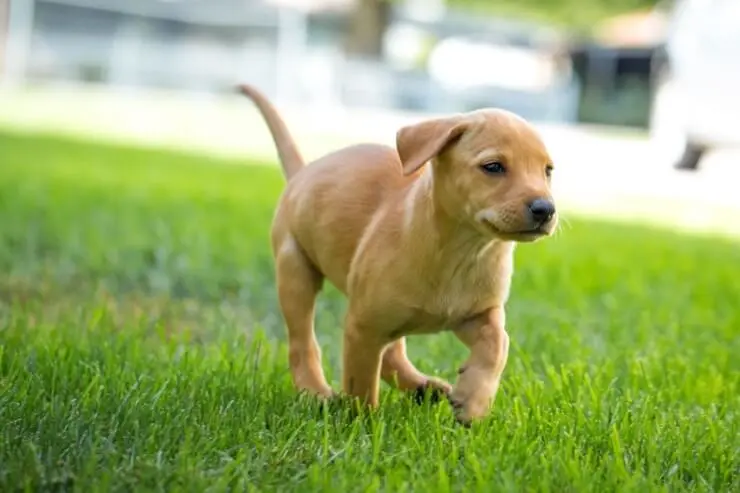
From Adobe Stock
Dachshund Lab Mix Quick Breed Summary
| Size | 15-25 inches |
| Weight | 30-60 pounds |
| Lifespan | 12-15 years |
| Coat | Short, dense, thick, water-resistant |
| Color | Black, chocolate, yellow |
| Shedding Tendency | Moderate |
| Temperament | Rambunctious, protective, talkative, stubborn and devoted |
| Intelligence | High |
| Socialization | Must be socialized young to remove territorial behavior |
| Destructive Behavior | Can be aggressive |
| People Skills | Friendly but requires social training |
| Good with Children | Yes |
| Activity Levels | Medium-high |
Origin of the Dachshund Lab Mix
Its exact origin remains a bit of an enigma, shrouded in the same mystery that often accompanies the creation of new hybrid breeds. This mix, believed to have first appeared in the late 20th or early 21st century, represents an adventurous endeavor in the world of canine breeding.
Unlike their purebred counterparts, the history of the Dachsador doesn’t trace back centuries, but rather unfolds over recent decades, reflecting a growing interest in combining distinct dog breeds for their complementary traits.
While the precise moment of the Dachshund Lab Mix’s inception is unclear, it’s widely accepted that this breed was intentionally created to merge the charming characteristics of the Dachshund with the gentle nature of the Labrador Retriever.
The Dachsador is a unique concoction of these traits, designed to be a loving and adaptable companion.
The Dachshund: A Historical Hunter
The Dachshund’s origins take us back to Germany in the 15th century, a breed developed with a very specific purpose – hunting. These dogs were especially valued for their ability to scent, chase, and flush out burrow-dwelling animals like badgers.
Their iconic elongated body and short legs were meticulously bred to excel in tunneling and digging, essential skills for their role as formidable hunters.
Over time, the Dachshund evolved, but it retained its tenacious hunting spirit and unique physique, endearing traits that continue to define the breed.
Despite its hunter roots, the Dachshund’s adaptable nature has allowed it to transition seamlessly into a beloved family pet. This transition from a dedicated hunter to a cherished companion highlights the breed’s versatility and enduring appeal.
The Dachshund’s journey from the forests and fields of Germany to the hearts of families worldwide is a testament to its enduring charisma and versatility.
The Labrador Retriever: From Fisherman’s Friend to Family Favorite
The Labrador Retriever’s story begins in the early 1800s in Newfoundland, Canada. Originally known as the St. John’s dog, this breed was an indispensable helper for local fishermen.
Labs were trained to retrieve fishing nets and lost catches from the icy waters, demonstrating an innate swimming ability and a natural inclination to retrieve. Their strong build, webbed feet, and water-resistant coat made them perfectly suited for this demanding work in harsh conditions.
Over time, the Labrador Retriever’s reputation for intelligence, good temperament, and trainability spread beyond Newfoundland, leading to its popularity as a family pet and a working dog in various fields.
Labs are now renowned for their roles in search and rescue, as therapy dogs, and as trusted companions.
The evolution of the Labrador Retriever from a hardworking fisherman’s aide to one of the most beloved breeds in the world speaks volumes about its adaptable nature and endearing personality.
Physical Appearance of the Dachsador
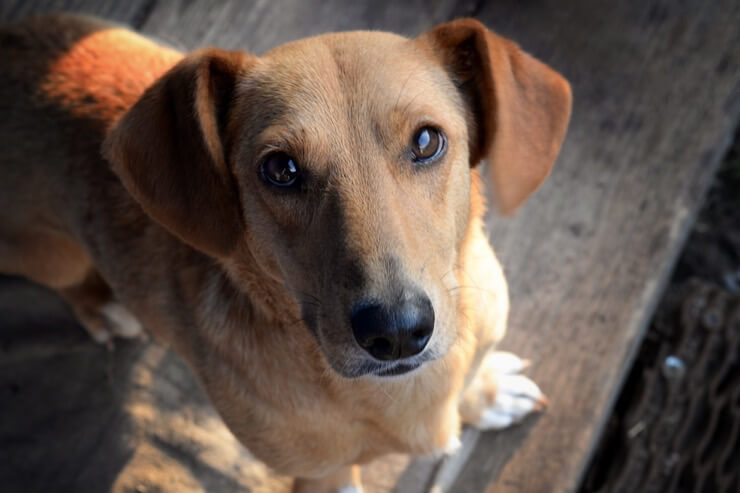
From Adobe Stock
Their physical appearance is a captivating blend of their parent breeds. This combination results in a dog that often captures the hearts of all who meet them.
Height and Weight
The Dachsador presents a unique range in both height and weight. These dogs typically find a middle ground between the Dachshund’s smaller size and the Labrador’s larger frame.
In terms of height, they often measure from 15 to 25 inches at the shoulder. This size reflects a comfortable compromise, making them neither too small nor too large.
Their weight, much like their height, varies and can be anywhere from 30 to 60 pounds. What’s particularly interesting is the variation even within the same litter.
From my experience, it’s not uncommon to see a noticeable difference in size among Dachsador siblings, each pup bringing its own distinct physicality to the mix.
Coat and Color
The coat of a Dachsador is a beautiful display of their mixed heritage. These dogs may inherit the Dachshund’s short, dense fur or the Labrador’s thicker, water-resistant coat. This genetic lottery results in a variety of coat types, ranging from sleek and short to slightly longer and more lush. The color palette of these dogs is equally diverse and fascinating.
Dachsadors can sport colors ranging from the classic blacks, chocolates, and yellows typical of Labs, to the dapples, brindles, and even piebald patterns seen in Dachshunds.
Each Dachsador I’ve encountered has showcased a unique coat pattern, reflecting their diverse genetic background in every shade and texture.
Other Features
The facial features of the Dachsador are as diverse and intriguing as their coats. They often feature the Labrador’s soulful eyes combined with the elongated, expressive face of the Dachshund. This mix gives them a contemplative, thoughtful appearance as if they’re always in a state of gentle reflection.
Their ears contribute significantly to their unique look, varying between the Dachshund’s longer, droopy ears and the Labrador’s shorter, perked ones. This diversity extends to their tails, paws, and even their posture.
Personality and Temperament of the Dachshund Labrador Mix
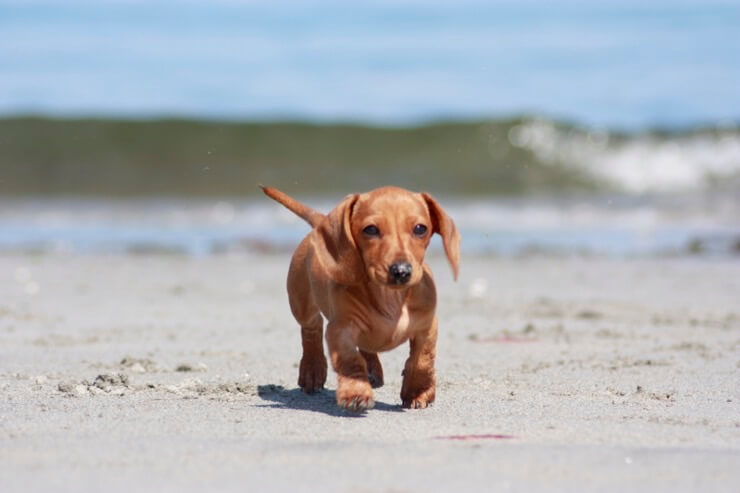
From Adobe Stock
Be prepared for a real wildcard when you bring one of these dogs home.
You will never really know their temperament until you raise them. The very best combination is a mix of the Labrador’s natural friendliness and the Dachshund’s protective nature.
A Lab Dachshund mix will be a devoted friend that will never leave your side.
Intelligent and Trainable
One of the most remarkable traits of the Dachsador is their intelligence, a gift they inherit primarily from the Labrador Retriever side of their lineage. This intelligence makes them highly trainable and able to pick up commands and tricks with relative ease.
In my experience, they respond best to positive reinforcement techniques, showing a keen eagerness to please their human companions. This trainability, combined with their sharp minds, means they can be taught a wide range of behaviors, from basic obedience to more complex tasks.
However, their Dachshund heritage can introduce a streak of independence into their training. Sometimes, they may exhibit a stubbornness that requires patience and consistency to overcome. But, this challenge also brings with it a rewarding experience.
Energetic and Affectionate
The Dachsador is a bundle of energy and affection. They often exhibit a playful and energetic temperament, loving to engage in activities like fetch, walks, and interactive play. This zest for life makes them great companions for active individuals and families.
Their energy is balanced with an equally strong capacity for affection. Dachsadors are known for their loving nature, often seeking physical closeness with their owners, such as cuddling and being petted. This affectionate demeanor makes them wonderful companions, providing both physical activity and emotional warmth.
One thing you can be sure of is that this dog will have a lot of energy. This hunting and sporting breed is born for the outdoors.
Your pooch will want to be walked often and played with even more, and will require games that tap into their high intelligence.
Aggressive Behavior
While aggression is not a trait typically associated with Dachsadors, it’s important to understand that any dog, regardless of breed, can display aggressive behavior under certain circumstances.
Aggression in Dachsadors could stem from various factors, such as lack of socialization, fear, anxiety, or territorial instincts. It’s crucial to address these behaviors early and with appropriate training and socialization.
It’s also important to note that Dachsadors may express their discomfort or assertiveness through barking. While not inherently aggressive, barking can be a sign of underlying issues such as anxiety, excitement, or a response to perceived threats. This is particularly noticeable in dogs that inherit the Dachshund’s strong vocal tendencies.
Caring for a Dachshund Lab Mix
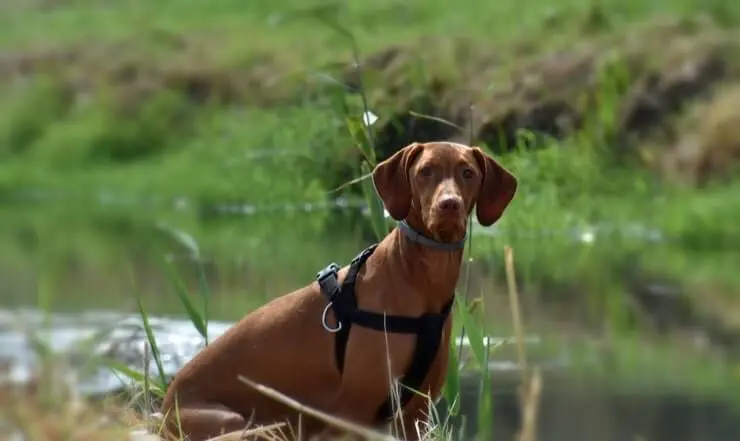
From Adobe Stock
If you’ve ever had the pleasure of raising either a Dachshund or a Labrador Retriever, prepare for a different experience with this mix. The Dachsador combines traits from both breeds, resulting in a pet that’s as unpredictable as it is delightful.
These dogs are vibrant and full of life. It’s essential to embrace a bit of noise and mischief in your daily routine – a quiet, inactive household might not be the best fit for this lively breed. They thrive in environments where they can access outdoor spaces freely, perfect for their exploratory and energetic nature.
Exercise Requirements: Keeping Up with Their Energy
Dachsadors are active dogs, requiring at least 60 minutes of exercise daily.
But here’s a tip: their exercise needs can vary depending on which parent breed they take after more. If your Dachsador has a Labrador build, they’ll likely enjoy longer, more strenuous walks. On the other hand, if they lean more toward the Dachshund side, it’s better to split their walks into shorter, more manageable sessions.
Remember, they possess a high prey drive, so keeping them leashed during walks is a must to manage their reactive tendencies.
Aside from walks, they’ll need an additional 30 minutes of play each day. A run or jog alongside you can be a great way to fulfill this. Believe me, keeping up with their exercise regime is not just good for them, but it can be a fantastic way for you to stay active as well!
Grooming and Shedding: More Than Just a Brush Stroke
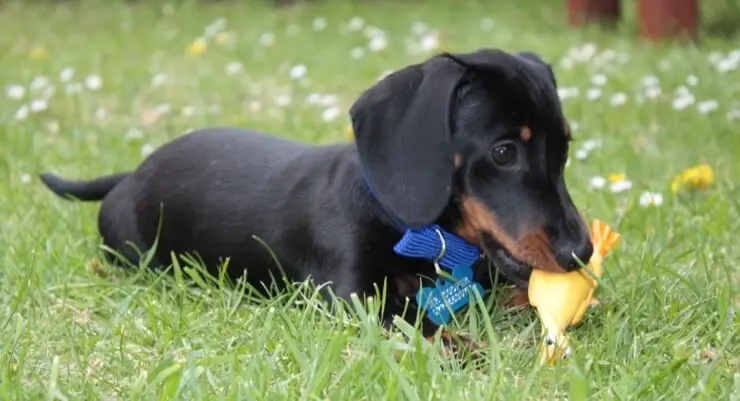
From Adobe Stock
The Dachsador demands a bit more attention than your average single-coated dog. Regardless of their coat length, plan on brushing them at least twice a week.
Shedding is moderate but can intensify during spring and fall. If your dog has a longer coat, be wary of tangles and mats, which can be quite uncomfortable for them.
Dental care is crucial. I recommend brushing their teeth three times a week, coupled with annual vet visits for a thorough dental checkup. Maintaining dental hygiene is key to preventing long-term health issues.
Feeding and Diet: Fueling Their Active Lifestyle
Dry dog food is typically the best option, and you might want to consider a breed-specific diet formulated for hunting dogs like Dachsador. About 2 cups of quality dry dog food per day should suffice, but remember, every dog’s needs can vary slightly.
It’s important to note that Dachsadors are more prone to obesity than some other breeds. Given their unique body shape, excess weight can be particularly harmful. Stick to their diet plan without too many extra treats to keep them in good shape.
The Most Common Health Problems Among Doxidors
As with any breed, they are susceptible to certain health issues. Being well-informed about these common health concerns can greatly aid Doxidor owners in providing the best possible care.
Intervertebral Disc Disease (IVDD)
This condition is particularly prevalent in Doxidors due to the Dachshund’s genetic predisposition. IVDD affects the spinal discs, causing them to degenerate and sometimes rupture, leading to pain, nerve damage, and in severe cases, paralysis.
Symptoms to watch for include noticeable back pain, changes in gait, reluctance to jump or move, and loss of bladder or bowel control. IVDD can drastically impact a dog’s mobility and comfort.
- Regular veterinary assessments for early detection
- Control and monitor weight to lessen spinal stress
- Restrict activities that may harm the spine, such as jumping
- Use harnesses instead of neck collars to reduce neck strain
- Consider physiotherapy or acupuncture for pain management
Hip Dysplasia
A genetic malformation of the hip joint, hip dysplasia is commonly seen in larger breeds like Labradors and can affect Doxidors. It causes arthritis and deterioration of the hip joint, leading to pain and mobility issues.
Signs include reluctance to exercise, difficulty in standing up, limping, and visible discomfort. This condition can significantly limit a dog’s physical activity and quality of life.
- Maintain a healthy weight to minimize pressure on the hips
- Engage in low-impact exercises to strengthen muscles without stressing the joints
- Use joint supplements as advised by a veterinarian
- Pain management through prescribed medications
- Consider orthopedic dog beds for better sleep comfort
Obesity
Obesity is a significant concern in Dachshund Lab Mixes, partly due to their potential lower activity levels and love for food. Excess weight exacerbates health issues like joint problems, diabetes, and respiratory difficulties.
Signs of obesity include visible weight gain, reluctance or inability to exercise, and difficulty in managing everyday physical activities.
- Implement portion control and avoid free-feeding
- Regular exercise tailored to the dog’s ability and health status
- High-quality, nutrient-rich diet with limited treats
- Routine weight checks and body condition assessments
- Work with a vet to create a weight loss plan if necessary
Allergies
Dachshund Labradors can inherit a tendency towards allergies, which may manifest as skin, digestive, or respiratory issues. Symptoms include persistent itching, skin redness, gastrointestinal upset, and recurrent ear infections. Allergies can affect a dog’s comfort and quality of life if not properly managed.
- Identify and eliminate potential allergens from the diet and environment
- Regular grooming and skin care to alleviate discomfort
- Prescription medications or special diets as recommended by a vet
- Keep the home environment clean and free of dust and pollen
- Frequent check-ups to monitor and adjust allergy management strategies
How to Train a Dachshund Lab Mix
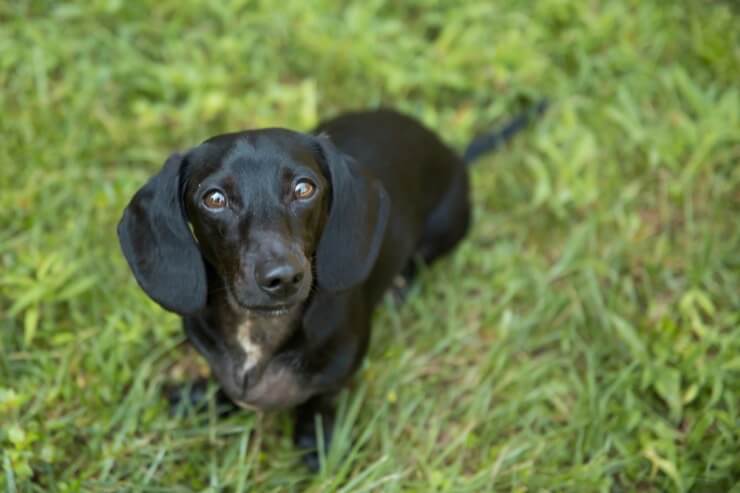
From Adobe Stock
Training a Doxidor can be a unique experience, full of challenges and rewards. Due to their mixed heritage, they inherit traits from both the Dachshund and the Labrador Retriever, which can influence their training approach.
Housebreaking: Patience is Key
Housebreaking a Doxidor can be particularly challenging due to their inherited traits. This breed’s somewhat snooty attitude can make the process a bit of a chore.
Remember, accidents are likely to happen, so keeping plenty of pee pads around is a good idea. Their small bladder size, a trait inherited from the Dachshund, means they can’t hold it in as well as some other breeds.
To aid in housebreaking, it’s effective to take them out first thing in the morning, after meals, naps, or playtime. Consistency and patience are crucial. And when they do succeed, be sure to offer plenty of praise to reinforce positive behavior.
Obedience Training: Overcoming Stubbornness
Other important aspects of training include obedience and counter-conditioning for unwanted behaviors like excessive barking. Doxidors can be stubborn, testing your patience at every turn.
Remain firm and consistent in your training approach, but always avoid showing frustration. This intelligent breed responds best to positive reinforcement and can become resistant to training if it senses negativity.
Stimulating Their Minds: Engaging Activities
An intelligent dog like the Dachsador will not tolerate boredom. They thrive with toys that move, light up, or make sounds. Puzzles and brain teasers are more stimulating for them compared to simple chew toys. Integrating games that engage their minds is crucial for their mental well-being.
A scavenger hunt, for example, is an excellent training game, particularly for a breed with hunting instincts. Watching your Doxidor use their keen sense of smell to sniff out toys can be a rewarding experience. You can even elevate the game by burying toys for them to find, tapping into their natural digging instincts.
The Cost of Owning a Dachshund Lab Mix
Owning a Dachshund Lab Mix, like any pet, comes with its set of financial responsibilities. The costs can vary depending on various factors such as location, the dog’s health, and the level of care you wish to provide.
Initial Costs
- Purchase Price: Depending on the breeder and the region, the cost of a Dachshund Lab Mix puppy can range from $300 to $800.
- Initial Veterinary Care (Vaccinations, Spaying/Neutering, Microchipping): Approximately $100 – $300. This includes essential vaccinations, spay/neuter surgery, and microchipping.
- Initial Supplies (Bed, Collar, Leash, Food and Water Bowls, Crate): Around $150 – $300. These are essential items needed to welcome your new puppy into your home.
Annual Costs
- Food: Expect to spend about $250 – $700 annually. The cost can vary based on the quality of the food and the size and appetite of your dog.
- Routine Veterinary Care (Annual Check-ups, Vaccinations): Approximately $200 – $500 per year.
- Pet Insurance: On average, pet insurance can cost between $200 and $600 annually, depending on the coverage level.
- Grooming: If you opt for professional grooming, it can cost around $30 – $70 per session, totaling around $180 – $840 annually, assuming a visit every 1-2 months.
- Miscellaneous (Toys, Treats, Training, Emergency Medical Expenses): Approximately $100 – $500 annually. This includes toys, treats, and other unforeseen expenses such as emergency veterinary visits.
FAQs on the Dachshund Lab Mix
Is the Dachshund Lab Mix a good family pet?
Yes, they are known for their affectionate and friendly nature, making them excellent family pets, especially in homes with children and other animals, provided they are well-socialized.
How long does a Dachshund Lab Mix live?
The average lifespan is around 12-15 years, though this can vary based on their health and living conditions.
Is a Dachshund Lab Mix easy to train?
Training can be a bit challenging due to their intelligent but sometimes stubborn nature. However, with patience, consistency, and positive reinforcement, effective training is achievable.
Do Dachshund Lab Mixes get along with other pets?
Yes, they usually get along well with other pets, especially when socialized from a young age. Their friendly nature often makes them good companions for other dogs and even cats.
Can Dachshund Lab Mixes participate in dog sports?
Yes, they can participate in dog sports like agility, obedience, and tracking. Their intelligence and energy make them well-suited for these activities, providing both physical exercise and mental stimulation.
So, Is the Dachshund Lab Mix Right For You?
Deciding if a Dachshund Lab Mix is the right dog for you involves considering its unique characteristics and how they align with your lifestyle, environment, and expectations from a pet.
This breed, a blend of the Dachshund’s playfulness and the Labrador’s loyalty, offers a distinctive combination of traits that can make for a wonderful companion. However, it’s important to understand what owning a Doxidor entails to ensure a happy, fulfilling relationship for both you and the dog.
Who the Dachshund Lab Mix Is For
- Families and Individuals Seeking an Affectionate Pet: With their friendly and loving nature, Doxidors make excellent companions for families, couples, and individuals. They thrive on companionship and fit well into homes where they can be a central part of daily activities.
- Active People: Given their moderate to high energy levels, they are perfect for those who enjoy an active lifestyle. Whether it’s long walks, hikes, or playing fetch, Dachshund Labs will happily join in the fun.
- First-Time Dog Owners Ready for a Challenge: For those new to dog ownership who are ready for the responsibilities of training and care, these dogs can be a great choice. Their intelligence and trainability make the training process rewarding, though it can be challenging at times.
- Those Who Enjoy Mental and Physical Engagement: If you like engaging with your pet through training, play, and exercise, a Dachshund Lab can be an ideal companion, as they excel in environments that stimulate both their body and mind.
Who the Dachshund Lab Mix Isn’t For
- People Seeking a Low-Energy or Independent Dog: If you prefer a more low-key or independent pet, a Doxidor might not be the best fit. They require regular exercise and thrive on interaction and engagement with their owners.
- Those With Limited Time for Training and Exercise: If your schedule doesn’t allow for regular walks, playtime, and training sessions, a Dachshund Labrador may not be the ideal choice. They need consistent exercise and mental stimulation to prevent boredom and behavioral issues.
- Potential Owners Looking for a Quiet Dog: Doxidors can be vocal, inheriting the barking tendencies of the Dachshund. If you live in an environment where a quiet dog is necessary, such as an apartment with strict noise rules, this may not be the breed for you.
- Families with Very Young Children Without Supervision: While Dachshund Labradors are generally good with children, their energy and size might be overwhelming for very young kids. Supervised interaction is always recommended.
More Dachshund and Labrador Retriever Mixes
Want a Dachshund mix or Labrador Retriever mix but aren’t keen on the Dachshund Lab mix? Check out these other hybrid dog breeds:







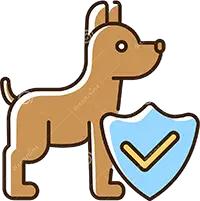



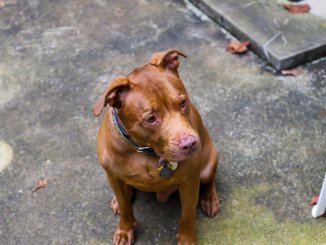



I have a 30 pound, 8 yr old Dachshund Lab mix and we have had a hilarious moment in every day. I call him my “alarm system” if someone parks on the street in front of our house or if they knock on the door, it is always the same…I can usually get him to stop barking when i say “no barking” and treat him when he stops. If I had to do it all again, I would in a heart beat. He has been such a joy!
I have a 4 year old Lab/Daschund and he is very active and definitely an alarm system. When he starts that barking it’s hard to get him to stop until I say No sir and he stops. He goes everywhere with me. He’s not big on water though. I’ve had him since he was 6 weeks old. His Mom is a full blooded lab and his Dad is the Daschund. He is chocolate.
I have a 7/8 wk old dachshund lab mix i knew she was mixed with something but yes she is very stubborn and tries to argue with me when im telling her not to do something her and my toddler are like best of friends I just got her a week ago and I have fallen in love with her even tho she gets on my nerves sometimes. She Loves to cuddle at night I know one thing this dog is giving me motivation to go on walks I have been trying to get active but didn’t have anything to motivate me until I got my puppy
I had a lb duchson mix for 11 years.he was the most lovavavl. Intelagent boy I have ever had.bfore that I had a ducshon for 13 years together they were great intelligent afectionant dogs. I have moved from AZ to Wyoming and am looking for a lab/douchson. We love dogs and would give this dog or dogs a great loving home. Gerald D Nelson